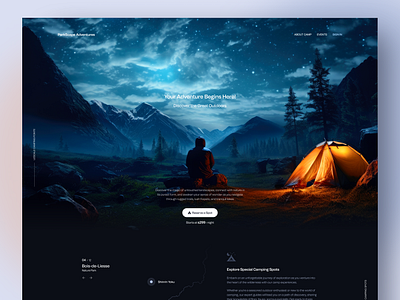Top Trends in Web Design That Will Shape the Future of Online Experiences
Wiki Article
How Reliable Website Design Can Increase User Experience and Conversions
In the increasingly competitive electronic landscape, reliable internet layout plays a pivotal duty in enhancing user experience and driving conversions. By concentrating on user-centric concepts, such as clear web content power structures and user-friendly navigation, businesses can develop interesting platforms that not just attract visitors yet additionally assist in smooth interactions. As we explore the crucial elements that add to effective website design, it ends up being noticeable that the effect on user contentment and conversion prices is extensive. Understanding these dynamics may discover techniques that could change exactly how individuals engage with your website.Significance of User-Centric Style
In the world of web design, focusing on user-centric design is paramount for producing effective digital experiences. This technique focuses on understanding the requirements, choices, and actions of users, making sure that electronic user interfaces are available and instinctive (Web design). By integrating customer feedback into the design process, web developers can craft experiences that reverberate with their target audience, ultimately causing enhanced involvement and contentmentUser-centric layout stresses functionality, which is crucial for lessening and preserving individuals bounce rates. When individuals can navigate an internet site easily, they are most likely to explore its web content and exchange customers. A user-centered method promotes trust fund and integrity, as customers really feel that their requirements are valued and resolved. This not only boosts their experience yet likewise encourages brand loyalty.

Crucial Element of Efficient Design
Effective layout functions as the foundation of user-centric website design, equating individual needs into aesthetic frameworks that promote communication. A well-organized format focuses on material via a clear pecking order, leading users' eyes to crucial details initially. This pecking order is usually established utilizing spacing, dimension, and shade, guaranteeing that critical elements stand out.One more trick aspect is making use of whitespace, which avoids overcrowding and boosts readability. Web design. Whitespace enables aspects to take a breath, making the total layout appear cleaner and simpler to navigate. Furthermore, uniformity in design elements, such as typefaces and colors, promotes knowledge and depend on, enabling customers to navigate the website with higher convenience
Grid systems can likewise be indispensable, giving a structure that lines up material rationally and aesthetically. This positioning enhances the user experience by creating an organized aesthetic flow. Flexibility in layout-- like responsive layout-- guarantees that websites execute well across different gadgets, providing to varied user choices.
Eventually, a reliable layout not only captivates customers but likewise motivates them to involve more deeply, eventually fulfilling and driving conversions company goals. By concentrating on these crucial elements, designers can create formats that reverberate with customers and enhance their overall experience.
Navigational Best Practices
Clear and intuitive navigation is crucial for enhancing individual experience on an internet site. A well-structured navigating system allows users to find information quickly, which directly impacts Visit This Link their fulfillment and chance of conversion additional hints - Web design. Carrying out a hierarchical framework is essential; utilize categories and subcategories that logically group related content, making it easier for site visitors to exploreUniformity in navigation elements is additionally essential. Make certain that food selections, web links, and buttons maintain uniformity in style, color, and positioning across all web pages, providing customers with an acquainted framework as they browse. Additionally, use detailed tags for navigating products. As opposed to generic terms, opt for clear tags that precisely show the material, assisting individuals in making informed choices.

Mobile Responsiveness and Ease Of Access

Access, on the various other hand, concentrates on making web sites usable for people with handicaps. This consists of adhering to guidelines such as the Internet Material Access Guidelines (WCAG), which deal with issues like color contrast, message dimension, and keyboard navigation. By implementing these requirements, web designers can develop inclusive experiences that provide to a broader target market, consequently improving individual engagement and satisfaction.
Check Out Your URL
In addition, mobile responsiveness and access not only improve customer experience but also favorably effect search engine rankings. Internet search engine focus on available and mobile-friendly internet sites, making them more probable to show up in appropriate search engine result. Subsequently, buying these facets of web design not just fulfills user demands yet also adds to total service success via raised presence and enhanced conversion prices.
Measuring Success Via Analytics
Tracking individual interactions and behaviors via analytics is vital for analyzing the success of a site. By leveraging tools such as Google Analytics, businesses can collect important data that exposes just how users involve with their website. Metrics such as bounce rates, ordinary session period, and conversion rates offer insights into user actions and can highlight locations for enhancement.Comprehending user demographics and traffic sources additionally boosts a site's performance. This data permits internet developers to tailor content and style components to much better meet the demands of their target audience. Additionally, tracking specific user journeys assists identify potential bottlenecks in the conversion channel, enabling organizations to enhance their website design accordingly.
Regularly assessing this analytics data is vital for continuous improvement. A/B testing different layout aspects can give concrete proof of what resonates with customers, enabling notified choices based on real-world efficiency. Inevitably, gauging success via analytics not just boosts customer experience yet additionally drives conversions, guaranteeing that website design efforts straighten with service goals. In a digital landscape where competitors is intense, taking advantage of the power of analytics is key to preserving a effective and easy to use website.
Verdict
In conclusion, efficient internet design plays a critical role in boosting user experience and driving conversions. Eventually, determining success via analytics permits for continual improvement, ensuring that design strategies remain aligned with user needs, thereby fostering organization development and success.In the significantly competitive digital landscape, efficient internet layout plays an essential role in enhancing customer experience and driving conversions. By integrating user responses into the layout procedure, internet designers can craft experiences that resonate with their target audience, eventually leading to boosted interaction and fulfillment.
Ultimately, the significance of user-centric design exists in its capability to create meaningful communications that drive conversions and foster long-term connections with individuals, making it an indispensable component of effective internet design strategies.
Eventually, gauging success with analytics not just enhances customer experience yet also drives conversions, making certain that web layout initiatives line up with company goals.In final thought, efficient web style plays a critical duty in boosting individual experience and driving conversions.
Report this wiki page